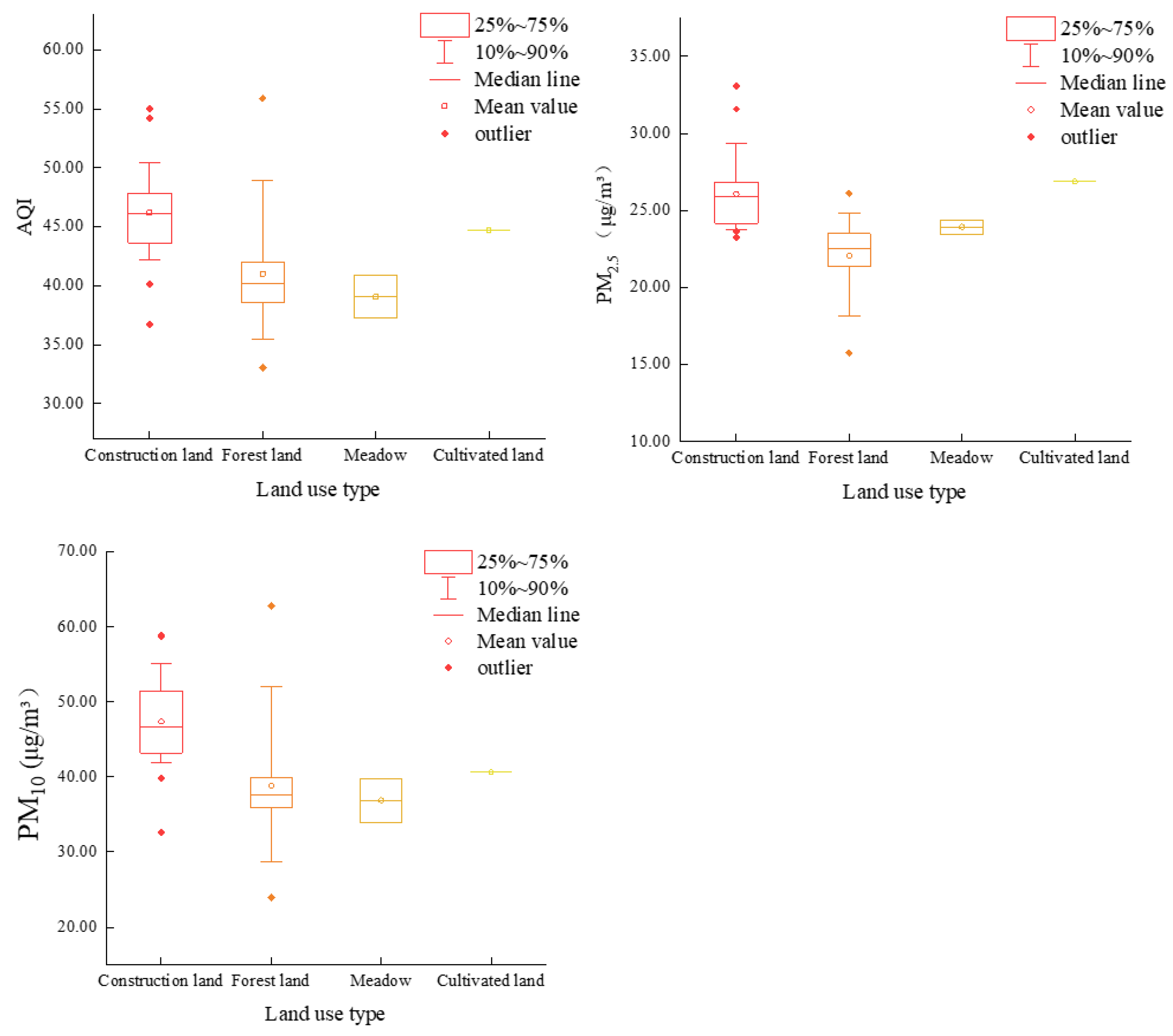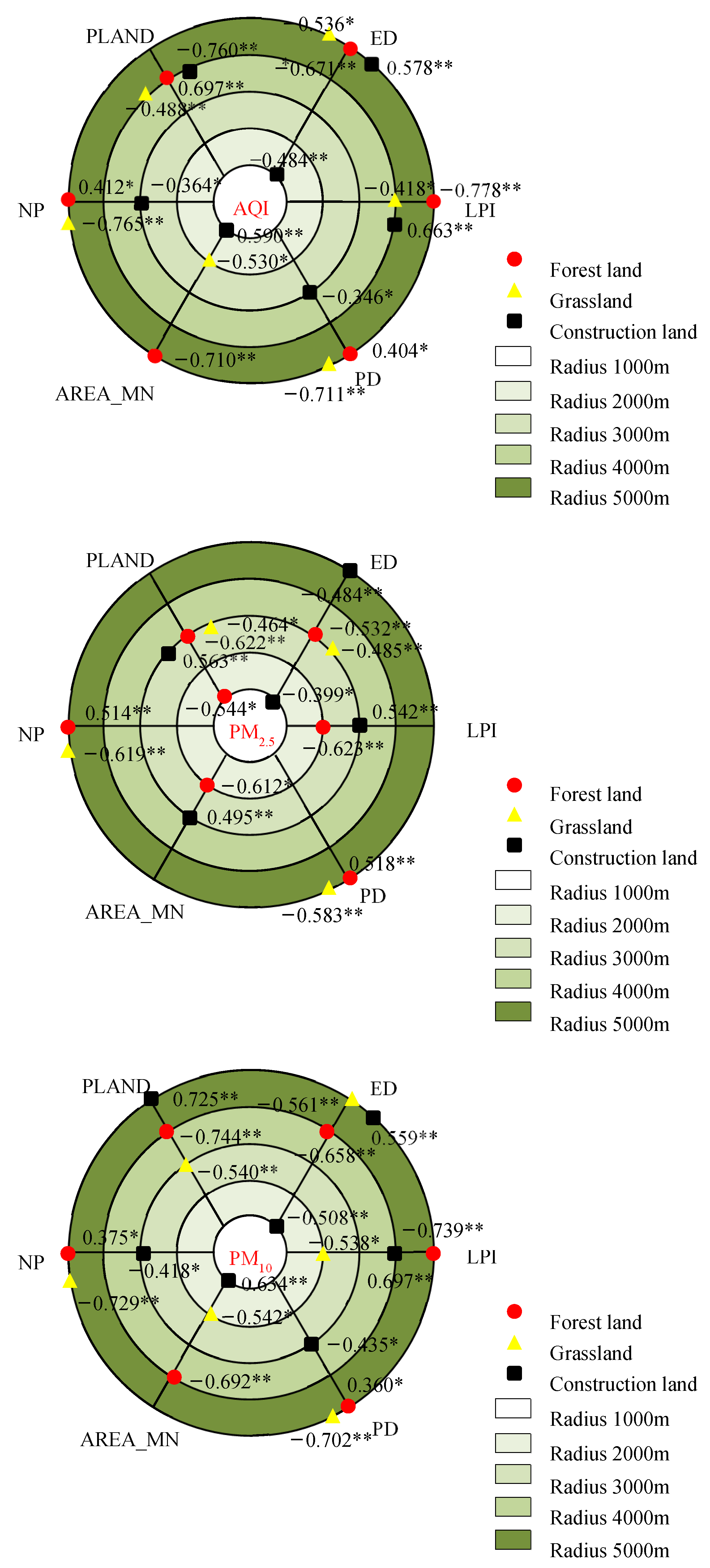Effects of Landscape Patterns on Atmospheric Particulate Matter Concentrations in Fujian Province, China
Abstract
:1. Introduction
2. Study Area and Methods
2.1. Study Area
2.2. Data Sources
2.3. Methods
2.3.1. Calculations of the Air Pollutant Concentrations at Stations under Different Land Use Types
2.3.2. Calculations of Landscape Metrics
2.3.3. Correlation Analysis
3. Results
3.1. Annual Atmospheric Particulate Matter Concentrations under Different Land Use/Cover Types and Landscape Patterns
3.2. Seasonal Atmospheric Particulate Matter Concentrations under Different Land Use/Cover Types and Landscape Patterns
3.3. Correlations between Landscape Patterns and Air Pollutant Concentrations
3.3.1. Correlations with the Annual Air Pollutant Concentrations
3.3.2. Correlations with the Seasonal Air Pollutant Concentrations
4. Discussion
5. Conclusions
Author Contributions
Funding
Institutional Review Board Statement
Informed Consent Statement
Data Availability Statement
Conflicts of Interest
References
- Dai, W.; Gao, J.Q.; Cao, G.; Ouyang, F. Chemical composition and source identification of PM2.5, in the suburb of Shenzhen, China. Atmos. Res. 2013, 122, 391–400. [Google Scholar] [CrossRef]
- Yan, G.X.; Yang, Z.; Xi, D.D. Characteristics and source analysis of Water-soluble ions in fine particulate matter PM2.5 in Xinxiang City in autumn. Acta Sci. Circumstantiae 2017, 38, 640–648. [Google Scholar]
- Chen, Y.; Xie, S.D.; Luo, B.; Zhai, C.Z. Pollution characteristics and sources of fine particulate matter in the main urban area of Chongqing. Acta Sci. Circumstantiae 2016, 37, 2420–2430. [Google Scholar]
- Duan, E.H.; Zhang, W.W.; Li, X.; Xiao, J.Y.; Yu, L.; Duan, L.L. Characteristics of PAHs pollution in fine particulate matter during heating period in Shijiazhuang City. Res. Environ. Sci. 2016, 30, 193–201. [Google Scholar]
- Song, H.X.; Yu, L.; Zhai, F.S.; Yu, S.C. Research progress in monitoring and controlling urban fine particulate matter PM2.5. J. Green Sci. Technol. 2018, 16, 29–32. [Google Scholar]
- Pui, D.Y.H.; Chen, S.C.; Zuo, Z. PM2.5 in China: Measurements, sources, visibility and health effects, and mitigation. Particuology 2014, 13, 1–26. [Google Scholar] [CrossRef]
- Yang, F.M.; He, K.B.; Ma, Y.L.; Chen, X.; Steven, H.C.; Tai, C.; Patricia, A.M. Variation characteristics and sources of trace elements in PM2.5 in Beijing. Environ. Sci. 2003, 24, 33–37. [Google Scholar]
- Wang, J.; Wang, X.K.; Zhang, H.X.; Lu, F.; Hou, P.Q. Study on the difference of PM2.5 concentration and element composition between two typical stations in Beijing urban area. Acta Sci. Circumstantiae 2012, 32, 74–80. [Google Scholar]
- Zhang, J.; Chen, Z.L. Analysis of pollution sources of small particulate matter in Beijing. Acta Sci. Circumstantiae 1998, 18, 62–67. [Google Scholar]
- Querol, X.; Alastuey, A.; Rodriguez, S.; Viana, M.M.; Artinano, B.; Salvador, P.; Mantilla, E.; Garcia do Santos, S.; Fernandez Patier, R.; de La Rosa, J.; et al. Levels of particulate matter in rural, urban and industrial sites in Spain. Sci. Total Environ. 2004, 334–335, 359–376. [Google Scholar] [CrossRef]
- Wang, Z.S.; Li, Y.T.; Chen, T.; Zhang, D.W.; Sun, F.; Pan, L.B. Spatial and temporal distribution of PM2.5 in Beijing in 2013. Acta Geogr. Sin. 2015, 70, 110–120. [Google Scholar]
- Li, S.; Deng, B.K.; Shao, J.X.; Xu, H.Q.; Li, L. Study on transition characteristics and influencing factors of PM2.5 mass concentration in Guiyang based on GIS. Ecol. Environ. Sci. 2014, 23, 1298–1304. [Google Scholar]
- Schaufler, G.; Kitzler, B.; Schindlbacher, A.; Skiba, U.; Sutton, M.A.; Zechmeister-Boltenstern, S. Greenhouse gas emissions from European soils under different land use: Effects of soil moisture and temperature. Eur. J. Soil Sci. 2010, 61, 683–696. [Google Scholar] [CrossRef]
- Li, S.P.; Liu, J.L.; Lin, J.; Fan, S.L. Spatial and temporal evolution of habitat quality based on land use change in Fujian Province from 1980 to 2018. Chin. J. Appl. Ecol. 2020, 31, 4080–4090. [Google Scholar]
- Hansen, M.C.; Potapov, P.V.; Moore, R.; Hancher, M.; Turubanova, S.A.; Tyukavina, A.; Thau, D.; Stehman, S.V.; Goetz, S.J.; Loveland, T.R.; et al. High-Resolution Global Maps of 21st-Century Forest Cover Change. Science 2013, 342, 850–853. [Google Scholar] [CrossRef]
- Liu, Y.P.; Wu, J.G.; Yu, D.Y. Characterizing spatiotemporal patterns of air pollution in China: A multiscale landscape approach. Ecol. Indic. 2017, 76, 344–356. [Google Scholar] [CrossRef]
- Łowicki, D. Landscape pattern as an indicator of urban air pollution of particulate matter in Poland. Ecol. Indic. 2019, 97, 17–35624. [Google Scholar] [CrossRef]
- Li, H.; Wu, J. Use and misuse of landscape indices. Landsc. Ecol. 2004, 19, 389–399. [Google Scholar] [CrossRef]
- McGarigal, K.; Cushman, S.A.; Neel, M.C.; Ene, E. FRAGSTATS: Spatial Pattern Analysis Program for Categorical Maps; University of Massachusetts: Amherst, MA, USA, 2002. [Google Scholar]
- Chen, A.L.; Sun, R.H.; Chen, L.D. The regulation function of green space pattern on urban surface thermal environment. Acta Ecol. Sin. 2013, 33, 2372–2380. [Google Scholar] [CrossRef]
- Weber, N.; Haase, D.; Franck, U. Assessing modelled outdoor traffic-induced noise and air pollution around urban structures using the concept of landscape metrics. Landsc. Urban Plan. 2014, 125, 105–116. [Google Scholar] [CrossRef]
- Maimaitiyiming, M.; Ghulam, A.; Tiyip, T.; Pla, F.; Latorre-Carmona, P.; Halik, M.; Sawut, M.; Caetano, M. Effects of green space spatial pattern on land surface temperature: Implications for sustainable urban planning and climate change adaptation. ISPRS J. Photogramm. Remote Sens. 2014, 89, 59–66. [Google Scholar] [CrossRef]
- Li, H.N.; Zeng, S.L. Correlation between land use change and air pollutants. J. Chengdu Univ. Inf. Technol. 2022, 37, 221–233. [Google Scholar]
- Han, B.W.; Ma, X.Y. Analysis on impact of strong haze events and weather situation in Yangtze River Delta during winter 2014–2018. Acta Sci. Circumstantiae 2020, 40, 2333–2345. [Google Scholar]
- Xiong, Y.F.; Ding, Q.J.; Shu, Z.Z.; Liu, Y.B.; Zhao, T.L. Meteorological impact of winter PM2.5 pollution process in the Yangtze River Delta based on numerical simulation and data assimilation. Acta Sci. Circumstantiae 2022, 42, 293–303. [Google Scholar]
- Chen, H.; Zhang, Y.J.; Zhan, Q.; Zhang, K.X.; Gai, X.L. Trend characteristics of atmospheric particulate matter in the Yangtze River Delta from 2015 to 2021 were analyzed based on KZ filtering method. Acta Sci. Circumstantiae 2023, 1–9. [Google Scholar] [CrossRef]
- Li, R.; Li, Q.; Xu, J.; Li, L.; Ge, C.J.; Huang, L.; Sun, D.H.; Liu, Z.Y.; Zhang, K.; Zhou, G.Z.; et al. Impact of regional air pollution processes in autumn and winter on typical cities in northern Yangtze River Delta. Environ. Sci. 2020, 41, 1520–1534. [Google Scholar]
- Zhang, X.Y.; Xu, X.D.; Ding, Y.H.; Liu, Y.J.; Zhang, H.D.; Wang, Y.Q.; Zhong, J.T. Impact of meteorological conditions on the decrease of PM2.5 mass concentration in key areas of China from 2013 to 2017. Sci. Sin. Terrae 2020, 50, 483–500. [Google Scholar]
- Zhou, S.J.; Cong, L.; Liu, Y.; Xie, L.M.; Zhao, S.Q.; Zhang, Z.M. Rainfall intensity plays an important role in the removal of PM from the leaf surfaces. Ecol. Indic. 2021, 128, 107778. [Google Scholar] [CrossRef]
- Tang, Y.K.; Liu, S.H. A study on the correlation between urban land use type and PM2.5 degree in Wuhan City. Resour. Environ. Yangtze Basin 2015, 24, 1458–1463. [Google Scholar]
- Ma, B.L.; Wang, L.; Hua, Y.C. Correlation analysis of fine particle pollutants and land cover landscape pattern in Beijing. For. Resour. Manag. 2021, 94–103. [Google Scholar] [CrossRef]
- Luo, B.R.; Cao, R.H.; Chen, X.; Hu, X.S.; Wang, Z.Y. Spatial and temporal distribution of traffic particles on urban slow roads. J. Shanghai Univ. (Nat. Sci. Ed.) 2022, 28, 582–593. [Google Scholar]










| Landscape Index | Definition |
|---|---|
| Proportion of landscape (PLAND) | This index reflects the percentage of the total area of a certain patch type to the entire landscape area, determining the basis of judging dominant landscape elements in the landscape. |
| Largest patch index (LPI) | The proportion of the largest patch of a certain patch type to the entire landscape area, and the change in its values can reflect the direction and strength of human activities. |
| Mean patch area (AREA_MN) | The average area of patches in the landscape or in each type. |
| Edge density (ED) | The boundary length or total boundary length of each patch type on a unit area, which reveals the degree of fragmentation of the landscape or type divided by the boundaries. |
| Number of patches (NP) | The number of patches in the landscape or in each type, which reflects the degree of landscape fragmentation. |
| Patch density (PD) | The basic index in the landscape pattern analysis. When the landscape area is fixed, it conveys the same information as the NP. |
Disclaimer/Publisher’s Note: The statements, opinions and data contained in all publications are solely those of the individual author(s) and contributor(s) and not of MDPI and/or the editor(s). MDPI and/or the editor(s) disclaim responsibility for any injury to people or property resulting from any ideas, methods, instructions or products referred to in the content. |
© 2023 by the authors. Licensee MDPI, Basel, Switzerland. This article is an open access article distributed under the terms and conditions of the Creative Commons Attribution (CC BY) license (https://creativecommons.org/licenses/by/4.0/).
Share and Cite
Lin, F.; Chen, X. Effects of Landscape Patterns on Atmospheric Particulate Matter Concentrations in Fujian Province, China. Atmosphere 2023, 14, 787. https://doi.org/10.3390/atmos14050787
Lin F, Chen X. Effects of Landscape Patterns on Atmospheric Particulate Matter Concentrations in Fujian Province, China. Atmosphere. 2023; 14(5):787. https://doi.org/10.3390/atmos14050787
Chicago/Turabian StyleLin, Fengyi, and Xingwei Chen. 2023. "Effects of Landscape Patterns on Atmospheric Particulate Matter Concentrations in Fujian Province, China" Atmosphere 14, no. 5: 787. https://doi.org/10.3390/atmos14050787




